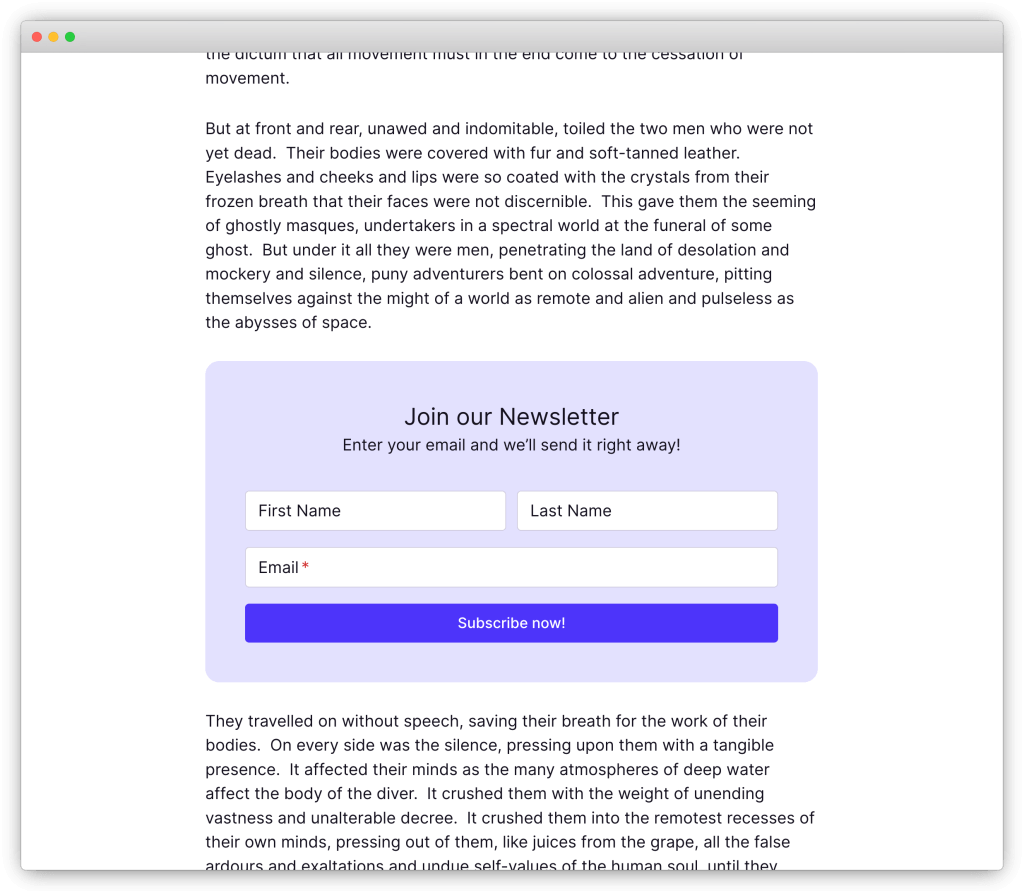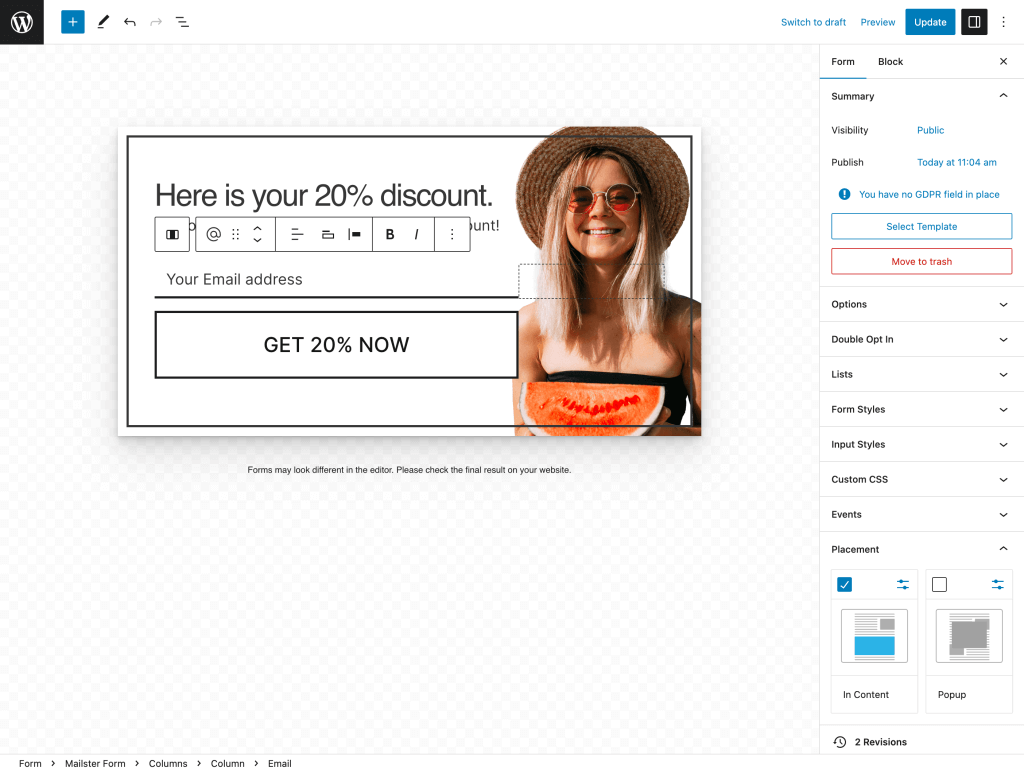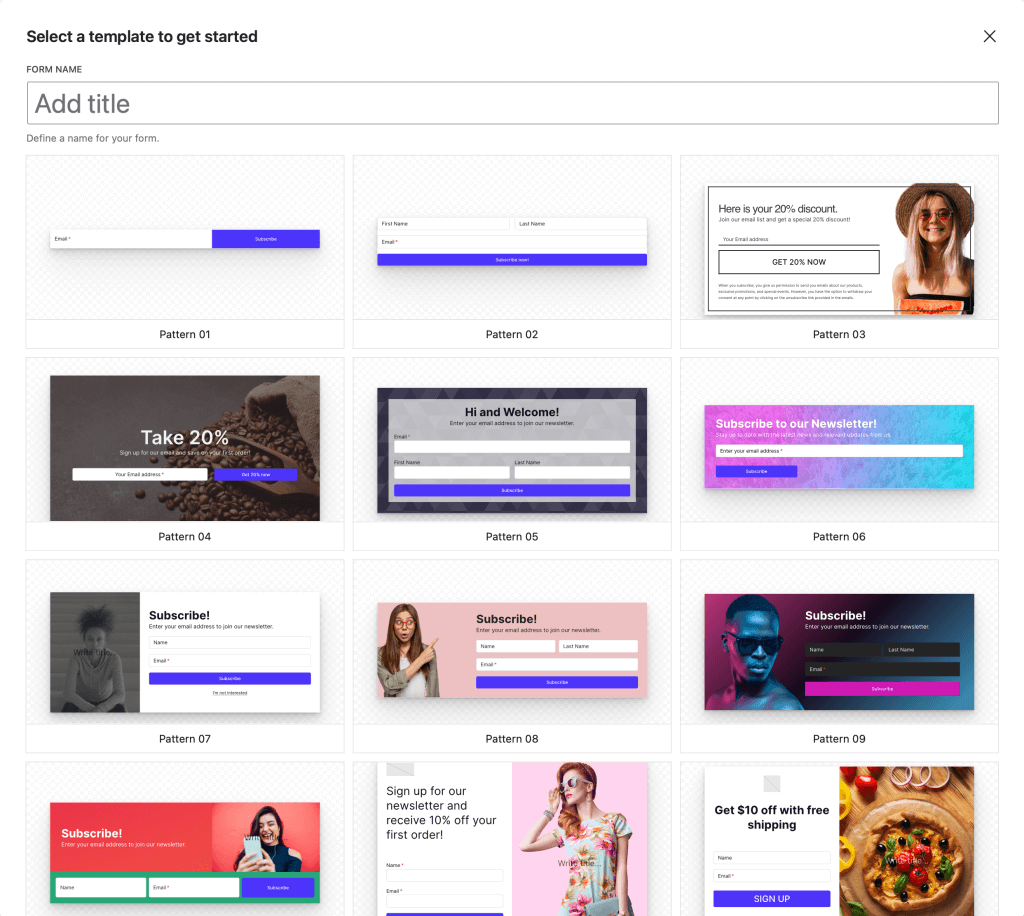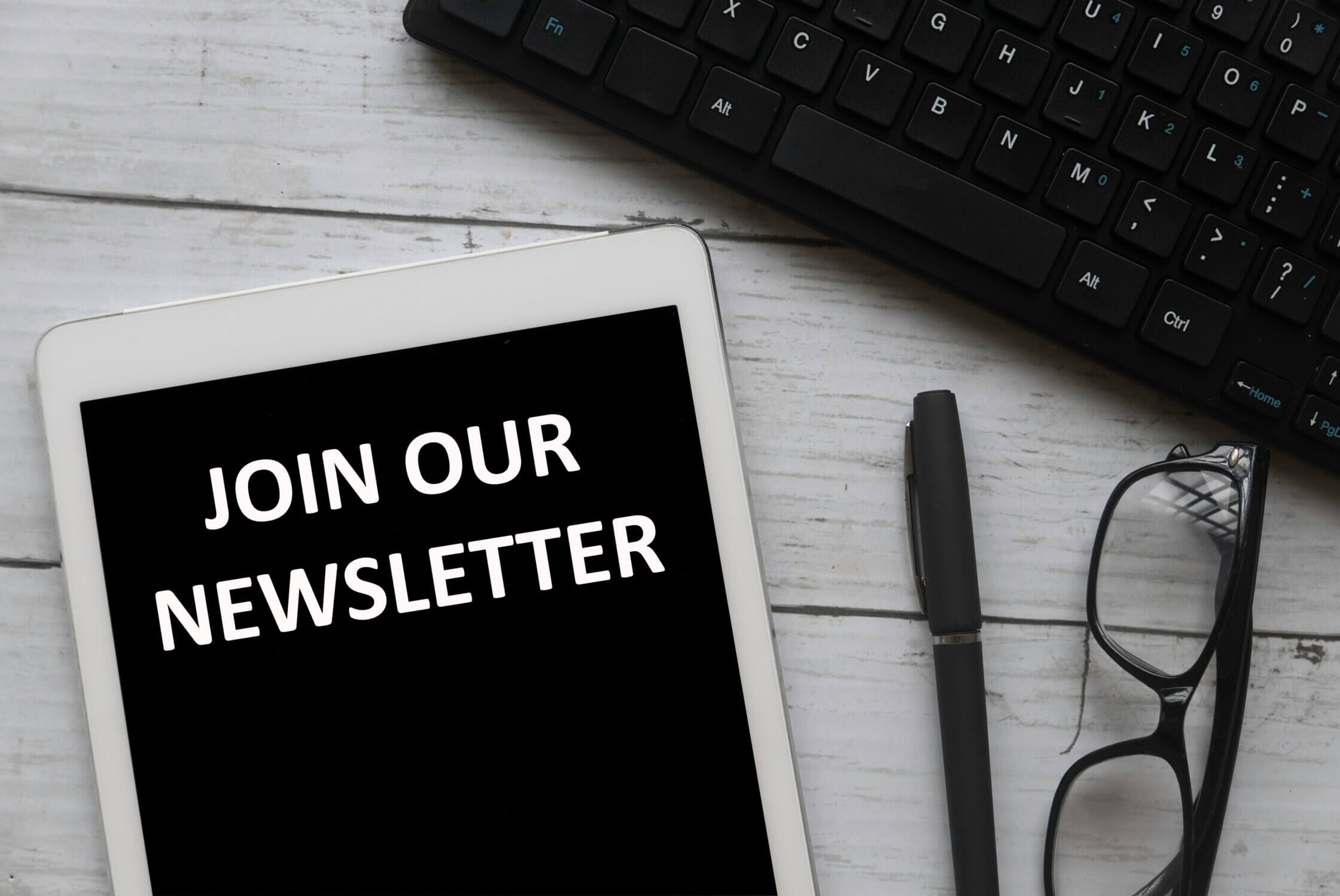Growing your email list is crucial for businesses to reach a larger audience. Creating a compelling newsletter signup form is essential to persuade potential subscribers to provide their email addresses. A newsletter signup form captures the email addresses of potential subscribers and serves as their consent to receive email marketing. In this article, we will provide tips for creating engaging newsletter signup forms and share examples worth emulating.

Key Takeaways:
- Creating a compelling newsletter signup form is crucial for growing your email list
- Simplicity and visual appeal are key when designing a signup form
- Incentives and clear messaging can persuade potential subscribers to sign up
- Leveraging social proof can build trust and encourage signups
- Timing is crucial when using popups to capture email addresses
What is a Newsletter Signup Form?
A newsletter signup form is a crucial tool for collecting email addresses from potential subscribers and building your email list. It serves as a way to seek permission from visitors to receive email marketing content. Newsletter signup forms can be integrated into your website or created using third-party tools, and they capture essential information such as the subscriber’s email address.
By completing the signup form, subscribers give their consent to receive email marketing, making it an effective way to grow your audience and engage with potential customers. Newsletter signup forms are an essential component of any email marketing strategy, allowing you to nurture relationships with prospects and turn them into loyal customers.
Creating a well-designed and user-friendly newsletter signup form is crucial to encourage visitors to provide their email addresses willingly. By customizing the form’s design, copy, and call-to-action, you can make it more visually appealing and persuasive. This will increase the chances of visitors becoming subscribers and receiving your valuable email content.

Table: Elements of an Effective Newsletter Signup Form
| Element | Description |
|---|---|
| Clear Call-to-Action | A prominent and persuasive call-to-action button that clearly communicates the action visitors need to take to sign up. |
| Minimalistic Design | A clean and visually appealing layout that aligns with your brand and focuses on the essential elements of the signup form. |
| Benefit-oriented Copy | Compelling copy that highlights the benefits of subscribing, such as exclusive content, discounts, or valuable resources. |
| Data Privacy Assurance | A statement assuring visitors that their information will be kept secure and not shared with third parties. |
| Social Proof | Showcasing social proof, such as subscriber counts or testimonials, to build trust and credibility. |
By incorporating these elements into your newsletter signup form, you can create a compelling and effective tool for growing your email list and driving engagement with your audience.
Tips for Creating an Engaging Signup Form Design
When it comes to creating an email signup form, the design plays a crucial role in capturing the attention of potential subscribers. To create an engaging and visually appealing form, follow these tips:
Simplicity is Key
A clean and simple layout is essential for a signup form. Avoid cluttering the form with unnecessary elements that can distract or overwhelm visitors. Stick to a clean design that aligns with your brand’s aesthetics.
Make Use of White Space
White space, also known as negative space, refers to the empty space around elements. It helps improve legibility and allows visitors to focus on the most important elements of the form. Use ample white space around form fields, headings, and the call-to-action button to make them stand out.
Use High-Quality Images
Images can add visual interest and support the message of your signup form. Choose relevant and high-quality images that align with your brand. For example, if you’re promoting a fitness newsletter, use images of people exercising or healthy food. The right images can help capture the attention of potential subscribers and make your form more visually appealing.
Highlight Benefits and Social Proof
In your signup form, clearly highlight the benefits that subscribers will receive by signing up for your newsletter. This can include exclusive content, discounts, or access to special events. Additionally, consider adding social proof, such as subscriber counts or testimonials, to build trust and credibility.
Optimize Placement and Design of the Call-to-Action Button
Your call-to-action (CTA) button is the most important element of your signup form. Make sure it stands out by using contrasting colors or fonts. Position the CTA button in a prominent location on the form, such as below the benefits and social proof, and ensure it is easy to spot.

| Tip | Description |
|---|---|
| Simplicity is Key | Avoid cluttering the form with unnecessary elements that can distract visitors. |
| Make Use of White Space | Use ample white space around form elements to improve legibility and draw attention. |
| Use High-Quality Images | Select relevant, high-quality images that support your message and align with your brand. |
| Highlight Benefits and Social Proof | Clearly communicate the benefits of signing up and incorporate social proof to build trust. |
| Optimize CTA Button | Ensure the call-to-action button stands out and is placed prominently on the form. |
The Power of Incentives and Clear Messaging
When it comes to optimizing your newsletter subscription form, incentives and clear messaging are two key factors that can significantly impact the conversion rate. By offering valuable incentives and effectively communicating the benefits of subscribing to your newsletter, you can entice more visitors to sign up and become loyal subscribers.
Offering Irresistible Incentives
One effective way to encourage visitors to subscribe to your newsletter is by offering them incentives in exchange for their email address. These incentives can come in various forms, such as a free ebook, exclusive content, or a discount code. By providing something of value, you give visitors a compelling reason to take action and subscribe to your newsletter.
For example, if you run an online fitness blog, you can offer a free workout guide or a personalized meal plan to new subscribers. This not only adds value to their subscription but also positions you as an expert in your niche and builds trust with your audience.
Communicating Clear Benefits
In addition to incentives, it’s crucial to clearly communicate the benefits that subscribers will receive by signing up for your newsletter. Use clear and concise messaging to highlight the exclusive content, special offers, or valuable insights they can expect to receive. This helps visitors understand the value they’ll gain from subscribing and motivates them to take the next step.
For instance, if you run a fashion blog, you can mention that subscribers will gain access to insider fashion tips, early access to sales, or exclusive style guides. By clearly outlining the benefits, you create a sense of anticipation and make visitors more excited about becoming a part of your newsletter community.
Leveraging Social Proof to Encourage Signups
Social proof is a powerful psychological tool that can significantly influence people’s decisions. When it comes to newsletter signups, leveraging social proof can help you boost your conversion rates and encourage more visitors to subscribe to your email subscription form. By showcasing the positive experiences of your existing subscribers, you can build trust and credibility with your potential audience.
Examples of Social Proof for Newsletter Signups
- Customer testimonials: Display testimonials from satisfied subscribers who share their positive experiences with your newsletter.
- Subscriber counts: Show the number of current subscribers to create a sense of popularity and value.
- Reputable certifications or ratings: Highlight any professional certifications or ratings your newsletter has received from trusted sources.
By incorporating social proof elements into your newsletter signup form, you can alleviate any doubts or concerns that potential subscribers may have. This can be especially effective for first-time visitors who are unsure about the value they will receive from signing up. Remember to regularly update and refresh your social proof to keep it relevant and engaging.
“I was hesitant to sign up for the newsletter at first, but after seeing the positive testimonials from other subscribers, I knew it was worth it. Now, I look forward to receiving valuable content in my inbox every week!” – Sarah, satisfied subscriber.
Finding the Right Timing for Popups
Popups can be an effective way to capture email addresses through your newsletter signup form. However, timing is crucial to ensure a positive user experience. You want to strike a balance between presenting the popup at the right moment and not overwhelming your visitors. Bombarding them with a popup as soon as they land on your site can be off-putting, leading to a negative impression.
To find the right timing for your popups, it’s important to consider your audience’s browsing behavior. Give your visitors some time to explore your website and appreciate its content before presenting them with a signup form. Waiting too long, on the other hand, may result in missed opportunities as visitors leave without signing up.
Based on research and best practices, it is recommended to have a well-designed and visually appealing newsletter popup appear within approximately 20 seconds of a visitor’s arrival on your site. This timing allows them to get a feel for your content and become more receptive to signing up for your newsletter. By aligning your popup with the overall user experience, you can increase the likelihood of capturing email addresses and growing your subscriber list.
Table: Pros and Cons of Different Popup Timing
| Pros | Cons | |
|---|---|---|
| Immediate Popup | – Can capture quick impulse signups – Immediately presents the signup form | – Can be perceived as intrusive – Visitors may not have had a chance to explore the site |
| Delayed Popup | – Allows visitors to engage with your content – Increases the likelihood of capturing more qualified leads | – Some visitors may never encounter the popup – Missed opportunities for immediate signups |
| Optimized Timing | – Balances user experience and capturing signups – Improves the chances of converting visitors into subscribers | – Requires continuous testing and optimization – Can vary based on website and audience behavior |
As with any aspect of your newsletter signup form, it’s important to continuously analyze and optimize your popup’s timing. Monitor your conversion rates and user feedback to determine if adjustments are needed. By finding the right timing for your popups, you can effectively capture email addresses and engage with your audience through your newsletter.
Crafting Compelling Call-to-Action Buttons
When it comes to your newsletter signup form, the call-to-action button is a crucial element that can make or break your conversion rate. To create a compelling call-to-action button, you need to ensure that it stands out and communicates a clear message to your visitors. Instead of settling for generic terms like “Send” or “Submit,” use more specific and persuasive wording that sparks curiosity and encourages action.
Consider using phrases like “Join the Club,” “Get Exclusive Access,” or “Unlock VIP Benefits.” These phrases not only convey a sense of exclusivity and value but also create a sense of belonging for your potential subscribers. By using language that resonates with your target audience and aligns with your brand, you can increase the chances of visitors clicking on your call-to-action button and signing up for your newsletter.
Another important aspect to consider is the design of your call-to-action button. Make sure it stands out from the rest of the form by using eye-catching colors, contrasting fonts, or even adding subtle animations. The goal is to draw the visitor’s attention to the button and make it visually appealing and clickable. Test different designs and placements to see what works best for your audience and encourages the highest conversion rate.
Table: Examples of Effective Call-to-Action Buttons
| Company | Call-to-Action Button Text | Color |
|---|---|---|
| Urban Fit | Start Your Fitness Journey | Green |
| Gourmet Delights | Get Delicious Recipes | Orange |
| Style Haven | Shop the Latest Trends | Blue |
In the table above, you can see examples of effective call-to-action buttons. Each button uses persuasive language that aligns with the company’s brand and target audience. The colors chosen for the buttons also stand out and create a sense of urgency and excitement. Remember that the key is to make your call-to-action button compelling, visually appealing, and aligned with the overall message and branding of your newsletter signup form.
Tips for Sending Confirmation and Welcome Emails
Once a visitor signs up for your newsletter through the email form signup, it’s important to send them a confirmation email to ensure that their email address is verified. This step is crucial for maintaining a high-quality email list and reducing the risk of spam. In the confirmation email, include a brief message thanking the subscriber for signing up and provide clear instructions on how to confirm their subscription. Encourage them to check their inbox, including the spam folder, to ensure they don’t miss any important emails from you.
After the subscriber confirms their email address, it’s time to send them a warm welcome email. This email serves as an introduction to your brand and sets the tone for future interactions. Begin by expressing your gratitude for their subscription and briefly explain what they can expect from your newsletter. Consider including a personalized message or a special offer to make them feel valued. This is also an opportunity to provide them with immediate value, such as access to exclusive content or a discount code. Make sure the welcome email is visually appealing, with clear and concise messaging that aligns with your brand identity.
In addition to the confirmation and welcome emails, you may also want to consider creating a series of onboarding emails. These emails can be sent over a period of time and provide new subscribers with more information about your brand, products, or services. Use this opportunity to nurture the relationship with your subscribers and encourage further engagement. Each onboarding email should offer unique and valuable content that keeps the subscriber excited about being a part of your newsletter community. Monitor the performance of these emails and make adjustments as needed to optimize their effectiveness.
| Email Types | Purpose |
|---|---|
| Confirmation Email | Verify email address and prevent spam |
| Welcome Email | Introduce the brand, provide immediate value, and set expectations |
| Onboarding Emails | Nurture the relationship, provide more information, and encourage engagement |
Examples of Effective Newsletter Signup Forms
Creating an engaging newsletter signup form is crucial for growing your email list and connecting with potential subscribers. By customizing your form to reflect your brand and offering clear benefits, you can encourage more signups. Let’s explore some examples of effective newsletter signup forms:
Cumber’s Corner: This lifestyle blog knows the importance of simplicity. Their signup form features a clean and visually appealing design, with a minimalistic layout and a captivating image that aligns with their brand. The form clearly highlights the benefits of signing up, such as exclusive content and updates. It also includes a reassuring statement that subscribers’ information will be kept confidential.
House of Lacuna: As a sustainable fashion company, House of Lacuna uses their signup form as an opportunity to showcase their products and offer a special promotion. The form features high-quality images of their fashionable items, enticing potential subscribers to join their newsletter. By providing a discount code for signing up, they create an immediate incentive for visitors to share their email addresses.
The Mrs. Book: This company specializes in creating heirloom-quality bridal books. Their signup form is a perfect example of an elegant and sophisticated design that reflects their brand. With a minimalistic layout and a touch of floral imagery, the form entices potential subscribers who resonate with their niche. The Mrs. Book also uses social proof by displaying the number of current subscribers, adding credibility to their brand.
| Example | Description |
|---|---|
| Cumber’s Corner | A lifestyle blog that focuses on simple living and self-improvement. |
| House of Lacuna | A sustainable fashion company that offers stylish and eco-friendly clothing. |
| The Mrs. Book | A specialized company that creates heirloom-quality bridal books. |
These examples demonstrate the power of customization and personalization in creating engaging newsletter signup forms. By taking inspiration from these successful forms and tailoring them to your own brand, you can create a compelling signup experience for your potential subscribers.
Remember, designing an effective signup form is just the first step. Continuously analyze and optimize your form to ensure maximum effectiveness in capturing email addresses and growing your email list.
The Impact of Interactive Content in Emails
Interactive content in emails has revolutionized the way marketers engage with their subscribers. By incorporating interactive elements, you can create a more immersive and personalized experience, leading to higher engagement rates and improved campaign performance.
Interactive emails provide a unique opportunity to capture your audience’s attention and encourage them to take action directly within the email itself. Whether it’s a survey, a game or quiz, or an e-commerce product preview, these interactive elements make your emails more dynamic and engaging.
One of the key benefits of interactive content is its ability to increase read time. Subscribers are more likely to spend time interacting with your email, exploring different options, and consuming the information you provide. This extended engagement not only enhances the user experience but also provides valuable data on how your audience interacts with your content.
Furthermore, interactive emails have been proven to have higher click-through and conversion rates compared to traditional static emails. By allowing subscribers to take action directly within the email, whether it’s making a purchase, submitting a form, or providing feedback, you can drive more meaningful interactions and achieve your campaign goals.
Implementing interactive content in your emails can also improve segmentation and personalization efforts. By using interactive elements, you can gather valuable data on subscriber preferences, interests, and behaviors. This information can then be used to fine-tune your email targeting and create more personalized and relevant campaigns.
Overall, the impact of interactive content in emails is undeniable. By leveraging interactive elements, you can create a more engaging and personalized experience for your subscribers, leading to higher engagement rates, improved campaign performance, and ultimately, better results for your business.
The Effective Types of Interactive Content in Emails
Interactive content in emails goes beyond just adding GIFs and buttons. It incorporates specific elements directly into the email design, prompting some form of action within the message. By leveraging interactive content, you can create engaging and interactive newsletters that capture the attention of your subscribers. Here are some effective types of interactive content that you can include in your emails:
Surveys
Adding surveys to your emails can triple engagement and response rates. Surveys allow you to gather valuable insights from your subscribers, helping you better understand their preferences and needs. You can use platforms like Google Forms or SurveyMonkey to create interactive surveys, and embed them directly into your emails using HTML code.
Games/Quizzes
Games and quizzes are interactive elements that can engage and entertain your subscribers. They can also help you gather data about your audience and their preferences. Consider adding a fun trivia quiz or a game that aligns with your brand to keep your subscribers entertained and encourage them to interact with your emails.
E-commerce Product Previews
If you sell products or services, including interactive previews in your emails can enhance the shopping experience for your subscribers. Allow them to browse and preview your products directly within the email itself. By incorporating interactive product previews, you can increase the chances of conversions and drive more traffic to your website or online store.
Company/Product Reviews
Including customer reviews or testimonials in your emails adds social proof and builds trust with your subscribers. Showcase positive feedback and experiences from satisfied customers to demonstrate the value and quality of your products or services. This interactive element can influence purchase decisions and encourage new customers to engage with your brand.
| Email Examples | Description |
|---|---|
| 1. XYZ Clothing Co. | An email from an online clothing retailer that includes an interactive quiz to help customers find their perfect style. |
| 2. Acme Fitness | A fitness brand that sends interactive emails with personalized workout recommendations based on the subscriber’s goals and fitness level. |
| 3. Yummy Recipes | An email newsletter that includes interactive recipe cards, allowing subscribers to customize ingredients and serving sizes. |
By incorporating interactive content into your emails, you can enhance the user experience, increase engagement, and ultimately drive better results for your email marketing campaigns. Experiment with different types of interactive elements to find what resonates best with your audience and aligns with your brand.
Benefits of Customizing Signup Forms
Customizing your signup forms offers several benefits that can enhance your email marketing strategy. By personalizing the experience for your audience, you can establish a deeper connection and make a lasting impression. Here are some key advantages of customizing your signup forms:
- 1. Increased conversion rates: When your signup form resonates with your target audience, they are more likely to provide their email addresses. By customizing the form to align with your brand and using persuasive language, you can capture the attention of potential subscribers and encourage them to sign up.
- 2. Improved targeting: Customized forms allow you to gather more specific information about your subscribers. By adding fields that capture relevant data, such as their interests or preferences, you can segment your email list and deliver more targeted content. This helps to ensure that your subscribers receive emails that are relevant and valuable to them.
- 3. Enhanced brand recognition: Customizing your signup forms with your branding elements, such as colors, logos, and fonts, creates a consistent and memorable experience. This helps to reinforce your brand identity and increases brand recognition among your subscribers.
- 4. Improved user experience: By customizing the design and layout of your signup form, you can create a visually appealing and user-friendly experience. A well-designed form that is easy to navigate and understand encourages users to complete the signup process.
Customizing your signup forms allows you to differentiate yourself from competitors and create a unique experience for your subscribers. By putting in the effort to tailor your forms to your audience, you can build trust, increase engagement, and ultimately, grow your email list.
Example of a Customized Signup Form
To illustrate the benefits of customizing signup forms, let’s take a look at an example from a fictional fitness brand called FitLife:
“Join the FitLife community and get exclusive fitness tips, workout plans, and healthy recipes delivered straight to your inbox! Don’t miss out on our special promotions and giveaways. Sign up now to start your fitness journey!”
In this example, FitLife has customized their signup form to appeal to individuals interested in fitness. The language used is motivating and highlights the benefits of signing up, such as receiving exclusive content and staying informed about promotions. The form also aligns with the brand’s style and incorporates their logo and colors, creating a cohesive and recognizable experience.
Table: Comparing Customized vs. Generic Signup Forms
| Customized Form | Generic Form | |
|---|---|---|
| Conversion Rate | Higher | Lower |
| Targeting | More specific | Less specific |
| Brand Recognition | Stronger | Weaker |
| User Experience | Enhanced | Standard |
This table highlights the differences between customized and generic signup forms. Customized forms have a higher conversion rate, allow for more specific targeting, enhance brand recognition, and provide an improved user experience compared to generic forms.
Steps for Customizing Signup Forms
Customizing your signup forms is a crucial step in creating a personalized and engaging experience for your potential subscribers. By customizing the wording, design, and overall look of your signup forms, you can stand out from the competition and make a lasting impression on your audience. Here are the steps to follow for an effective signup form customization:
Step 1: Assess Your Current Signup Process
To begin customizing your signup forms, take a closer look at your current signup process. Sign up for your own list as if you were a new subscriber and evaluate the experience. Identify any areas that need improvement, such as unclear instructions, lengthy form fields, or a lack of visual appeal. By understanding the existing shortcomings, you can make targeted improvements to enhance the user experience.
Step 2: Align with Your Writer Persona
Your signup forms should reflect your unique writer persona and the branding of your content. Consider using language and phrases that align with your brand voice and resonate with your target audience. Personalize your forms by adding a touch of personality to make them more relatable and memorable. Remember, the goal is to create a genuine connection with your potential subscribers.
Step 3: Add Branding Elements
Make your signup forms visually appealing and consistent with your brand by adding branding elements. Incorporate your brand colors, fonts, and logo into the design of your forms. This will help reinforce your brand identity and create a cohesive experience for your audience. Additionally, consider using relevant images or graphics that complement your content and resonate with your audience.
Step 4: Test and Optimize
Before launching your customized signup forms, it’s crucial to test them thoroughly. Check the forms on different devices and screen sizes to ensure they are responsive and visually appealing across platforms. Have others sign up and provide feedback on their experience. Continuously monitor the performance of your signup forms and make optimizations based on user behavior and feedback. This iterative approach will help you create highly effective and engaging signup forms over time.
By following these steps, you can customize your signup forms to create a personalized and engaging experience for your potential subscribers. Remember, each customization should align with your writer persona and the unique value you provide. So, go ahead and start customizing your signup forms to make a memorable impression with your audience!
Importance of Uniqueness and Personal Connection
Customizing your signup forms is more than just a design choice – it’s an opportunity to establish a personal connection and stand out from the crowd. By infusing your forms with unique aspects of your personality or brand, you create a more memorable experience for your subscribers. This personal touch helps you resonate with the right audience and repel those who aren’t your ideal readers.
Embracing your uniqueness and showcasing it in the signup process allows you to create a genuine connection with your subscribers. Whether it’s through your tone of voice, the imagery you use, or the benefits you highlight, personalization sets you apart and encourages signups from those who truly resonate with your brand.
Creating a memorable experience right from the start is key to building a loyal and engaged subscriber base. By customizing your signup forms and letting your personality shine through, you set the stage for emails that are eagerly opened and read.
Conclusion
Customizing your email form signup newsletter is crucial for boosting engagement and establishing a genuine connection with your subscribers. By following the tips and examples provided in this article, you can create compelling signup forms that reflect your brand, provide clear benefits, and encourage signups.
Remember to continuously analyze and optimize your forms to ensure maximum effectiveness. Pay attention to the design, messaging, and timing of your signup forms to capture the attention of potential subscribers and increase your email list.
Now, go ahead and start growing your email list with engaging signup forms! Take advantage of the power of customization to stand out from the crowd and build a personal connection with your audience. The success of your email marketing campaigns starts with an enticing and well-crafted email form signup newsletter.
FAQ
What is a newsletter signup form?
A newsletter signup form is a tool used to collect email addresses from potential subscribers. It allows businesses to build their email lists and seek permission to send marketing emails.
Why is creating an engaging signup form design important?
Creating an engaging signup form design is important because it attracts potential subscribers and encourages them to provide their email addresses. A visually appealing layout, relevant images, and clear benefits can persuade visitors to sign up for the newsletter.
How can incentives and clear messaging boost signups?
By offering incentives such as a free ebook or discount code, you can entice potential subscribers to sign up for your newsletter. Communicating the value they will receive from the newsletter and addressing their pain points can also persuade them to provide their email addresses.
How can social proof encourage signups?
Displaying the number of current subscribers or including testimonials from satisfied subscribers builds trust and encourages new visitors to join. Professional certifications or ratings from reputable sources can also enhance credibility and trustworthiness.
What is the right timing for using popups?
It’s important to find the right balance when using popups. Bombarding visitors with a signup form immediately can be off-putting, but waiting too long may result in missed signups. Understanding your audience’s browsing behavior is crucial in determining the optimal timing for a popup.
How can a compelling call-to-action button improve signups?
A clear and enticing call-to-action button that clearly communicates what will happen after signing up can encourage visitors to take action. Using eye-catching colors or fonts can help the button stand out from the rest of the form.
Why is sending confirmation and welcome emails important?
Sending a confirmation email verifies the email addresses of new subscribers and ensures they receive important emails. The welcome email provides an opportunity to introduce new subscribers to your brand, products, or services and offer immediate value.
Can you provide examples of effective newsletter signup forms?
Examples of effective newsletter signup forms include Cumber’s Corner, House of Lacuna, and The Mrs. Book. These forms demonstrate the importance of customization, personalization, and clear benefits in attracting subscribers.
What is the impact of interactive content in emails?
Interactive content in emails engages subscribers and improves email marketing results. Interactive elements increase read time, provide clearer data on campaign performance, and bring higher engagement rates compared to traditional emails.
What are the effective types of interactive content in emails?
Effective types of interactive content in emails include surveys, games/quizzes, e-commerce product previews, image carousels, and interactive invitations. These types of content boost segmentation, ROI, and customer loyalty.
What are the benefits of customizing signup forms?
Customizing signup forms helps establish a more personal connection with subscribers and makes your brand more memorable. It attracts the right audience, repels non-ideal readers, and creates multiple points of connection.
What are the steps for customizing signup forms?
To customize signup forms, start by doing a cursory check of your current signup process. Sign up for your own list, change the wording, add branding elements, and test the forms on different devices. Analyzing and optimizing your forms is important for maximum effectiveness.
Why are uniqueness and personal connection important in signup forms?
Uniqueness and personal connection in signup forms help you stand out and establish a genuine connection with subscribers. By sharing unique aspects of your personality or brand, you will resonate with the right audience and create more engaged subscribers.
How can I boost engagement with my email form signup newsletter?
By following the tips and examples provided in this article, you can create compelling signup forms that reflect your brand, provide clear benefits, and encourage signups. Continuous analysis and optimization of your forms will ensure maximum effectiveness in growing your email list.


